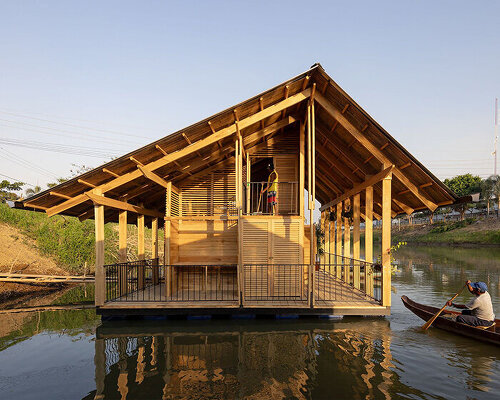natura futura works toward riverfront recovery
The Floating Neighborhood of Las Balsas, or ‘the rafts,’ rises along the Babahoyo River in Ecuador, where Natura Futura Arquitectura has collaborated with residents to reinforce a historic riverine way of life. Developed on the water’s edge, the project addresses a transformation that reshaped the community over the past two centuries. The Babahoyo River once supported more than two hundred fifty floating houses. By 2010, most families had been relocated to public housing further inland, severing their link to commerce and daily routines along the river.
Today, only a small number of dwellings remain afloat, many in fragile condition. Natura Futura approaches this floating neighborhood as an opportunity to restore the relationship between people and water through architecture grounded in local knowledge.
The proposal introduces a shared public and private place for long-term inhabitants, structured around the recovery of traditional timber building techniques. The aim is to reinforce a floating ecosystem where housing, work, and community life maintain a direct connection to the river.
images courtesy Natura Futura Arquitectura
seven floating homes revived in ecuador
Working together with local families and re:arc Practice Lab, the architects at Natura Futura establishes the floating neighborhood as a framework for rehabilitating seven existing houses of varying sizes. The work also includes the restoration of the riverbank with endemic vegetation and the formation of floodable public spaces that respond to water levels. This spatial diagram supports a neighborhood in continuous dialogue with its setting.
At the core of the system are floating platforms and replicable wooden truss modules that expand or contract according to each resident’s needs. Lightweight metal components, recycled flotation tanks, and local wood create structures tuned to withstand intense winter seasons. Floodable walkways, dry toilets, and filtration systems provide clean water and stable circulation paths where conventional infrastructure would falter.
Natura Futura reinforces a historic way of life along the Babahoyo River
a collaborative, community-centric approach
The project emerged through a participatory process that relied on the community’s understanding of the river’s movement and the specific requirements of floating life. Their input shaped material decisions, spatial configurations, and construction methods, which serves to strengthen the proposal’s relationship with place. The collaborative approach also addressed daily practices such as fishing and recycling, along with accessibility concerns for a disabled resident.
Seven mobile access points, one hundred fifty meters of floodable walkways, and a public platform bring together homes, local commerce, and communal gathering areas. The dry toilet and filtration systems prevent hundreds of cubic meters of wastewater from entering the river each year, lowering pollution loads and improving the health of the ecosystem.
the project restores a floating neighborhood through public and private spaces for residents
Riverbank Restoration
Urban strategies extend to the rehabilitation of seven hundred fifty square meters of riverbank, planted with native species including Pechiche and Matapalo. These trees withstand prolonged flooding and help control soil erosion, aiding the regeneration of a riparian ecosystem that has been under pressure for decades. Vegetative restoration advances the recovery of plant species and stabilizes slopes along the water.
A management model ensures that families retain property and usage rights while the municipality offers technical support to maintain shared infrastructure. This approach supplements the architectural work with a governance structure oriented toward continuity and resilience, reinforcing the floating neighborhood as an evolving civic landscape.
seven existing houses are rehabilitated with adaptable wooden truss modules
floodable walkways and floating platforms maintain access as water levels change
local wood, metal structures, and recycled flotation tanks support seasonal resilience
community knowledge informs materials, organization, and construction techniques
a management model preserves family ownership while ensuring long-term maintenance
project info:
name: The Floating Neighborhood of Las Balsas (El Barrio de las Balsas)
architecture: Natura Futura Arquitectura | @naturafuturarq
location: Babahoyo, Ecuador
collaborator: re:arc Practice Lab | @rearc.institute
completion: 2025
photography: © Natura Futura Arquitectura
The post natura futura restores floating neighborhood of seven ‘raft’ houses in ecuador appeared first on designboom | architecture & design magazine.

